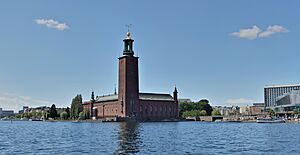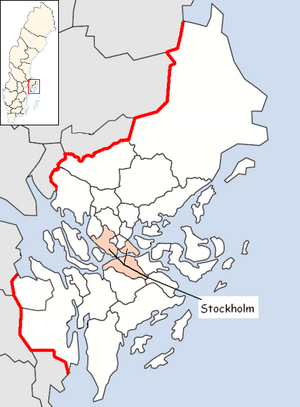Stockholm Municipality facts for kids
Quick facts for kids
Stockholm Municipality
Stockholms kommun
|
|||
|---|---|---|---|

Stockholm City Hall
|
|||
|
|||
 |
|||
 |
|||
| Country | Sweden | ||
| County | Stockholm County | ||
| Seat | Stockholm | ||
| Area | |||
| • Total | 216.237289 km2 (83.489684 sq mi) | ||
| • Land | 188.057289 km2 (72.609325 sq mi) | ||
| • Water | 28.18 km2 (10.88 sq mi) | ||
| Area as of January 1, 2010. | |||
| Population
(June 30, 2012)
|
|||
| • Total | 837,031 | ||
| • Density | 3,870.8911/km2 (10,025.562/sq mi) | ||
| Time zone | UTC+1 (CET) | ||
| • Summer (DST) | UTC+2 (CEST) | ||
| ISO 3166 code | SE | ||
| Province | Uppland and Södermanland | ||
| Municipal code | 0180 | ||
Stockholm Municipality is a special area in Sweden that manages its own local affairs. It is often called the City of Stockholm (in Swedish, Stockholms stad). This municipality is located in the central-eastern part of Sweden, within Stockholm County.
It is the largest municipality in Sweden when it comes to how many people live there. It also has one of the smallest land areas. This makes it the second most crowded municipality in Sweden. It is also the most populated municipality in all the Nordic countries.
Even though its official legal name is Stockholms kommun (Stockholm Municipality), the local government has chosen to use Stockholms stad (City of Stockholm) whenever possible. This is just a name choice and does not change its legal status as a municipality.
Geographically, the city includes the central part of Stockholm and two areas with suburbs. These are called Söderort (South Stockholm) and Västerort (West Stockholm). For administrative purposes, the municipality is divided into 14 smaller areas. These areas are managed by their own local councils.
Contents
A Brief History of Stockholm's Local Government
When Sweden first set up local governments in 1863, the City of Stockholm was one of the 89 cities in the country. A special group called the city council was chosen to make decisions for the city.
The original city area was mostly what is now called Innerstaden (the inner city). Over the years, more land was added to the city in 1913, 1916, and 1949. Until 1968, Stockholm City had its own governor and was separate from Stockholm County. In 1971, a big change made Stockholm a regular municipality, just like all the others in Sweden.
Where is Stockholm Municipality Located?
The City of Stockholm includes the main central part of the capital, known as Innerstaden or Stockholm City Centre. It also covers the southern and western suburban areas. These are called Söderort (South Stockholm) and Västerort (West Stockholm).
Almost everyone living in the municipality is part of the larger Stockholm urban area. This urban area is a tätort, which means a built-up area. It stretches out into ten other nearby municipalities.
Understanding Stockholm's Population Changes
How Has Stockholm's Population Grown?
The number of people living in Stockholm Municipality has changed a lot over the years. This chart shows how the population has grown from 1970 to 2019.
| Year | Population | ||||||||
|---|---|---|---|---|---|---|---|---|---|
| 1970 |
744,912
|
||||||||
| 1975 |
665,202
|
||||||||
| 1980 |
647,214
|
||||||||
| 1985 |
659,030
|
||||||||
| 1990 |
674,452
|
||||||||
| 1995 |
711,119
|
||||||||
| 2000 |
750,348
|
||||||||
| 2005 |
771,038
|
||||||||
| 2010 |
847,073
|
||||||||
| 2015 |
923,516
|
||||||||
| 2017 |
949,761
|
||||||||
| 2019 |
974,073
|
||||||||
|
Source: SCB - Population by region, marital status, age and sex. |
|||||||||
As you can see, the population decreased a bit in the 1970s and early 1980s. However, since then, it has been growing steadily. By 2019, nearly a million people lived in Stockholm Municipality.
Education Levels in Stockholm
Many people in Stockholm have a high level of education. About 42.4% of the people living there have completed education after high school that lasted three years or more. This is much higher than the national average for Sweden, which is about 27.0%. This shows that Stockholm is a place where many people pursue advanced learning.
Stockholm's International Connections
Sister Cities Around the World
Stockholm has a special approach to connecting with other cities around the world. Instead of signing formal agreements, Stockholm aims to have informal "town twinning" relationships with all the capital cities globally. It focuses especially on capitals in northern Europe.
Even though Stockholm does not sign official treaties, some cities believe they have established such agreements in the past. These cities claim to be twinned with Stockholm:
|
Famous People from Stockholm Municipality
Many notable individuals have come from Stockholm Municipality. One example is:
- Kerstin Abram-Nilsson (1931-1998), who was an artist, a debater, and someone who worked to improve society.
Images for kids
See also
 In Spanish: Municipio de Estocolmo para niños
In Spanish: Municipio de Estocolmo para niños



